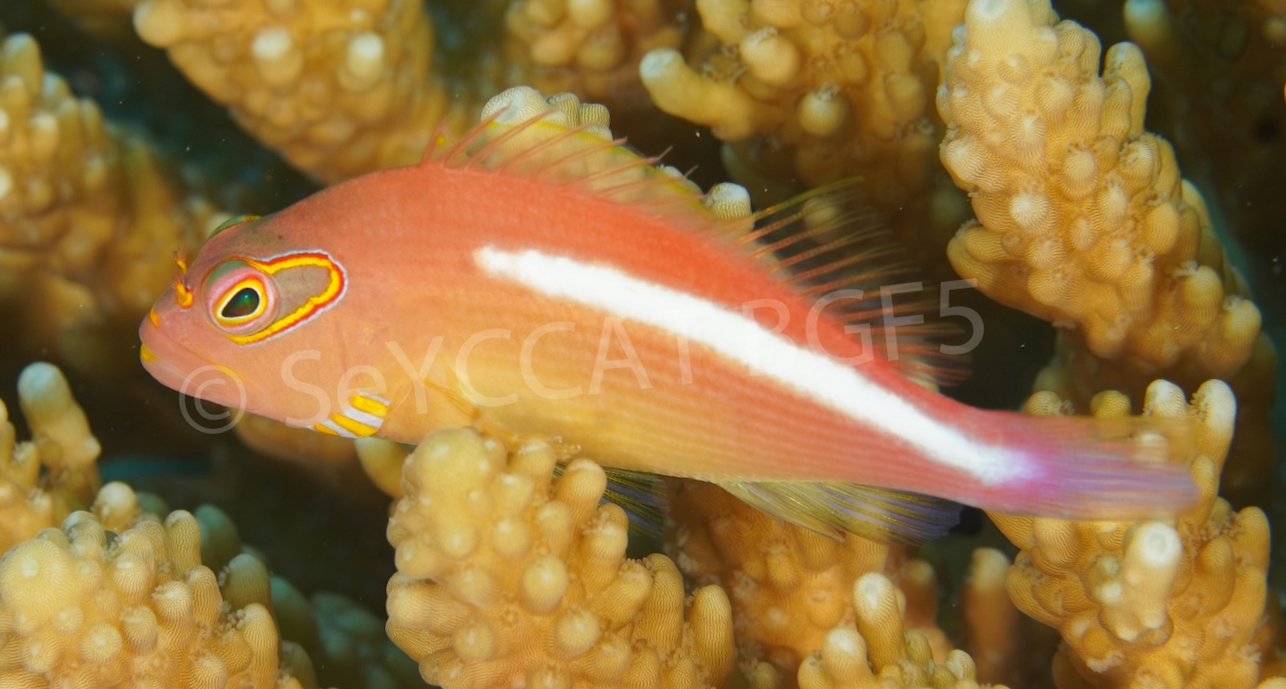Description:
Dorsal spines: 10; Dorsal rays: 11; Anal spines: 3; Anal rays: 6.
Medum-sized hawkfish. Body elongate. Snout short. Mouth large, the maxilla reaching posterior to a vertical at centre of eye. Cirri in front of eye. 5 or 6 rows of scales on
cheek. Interorbital space and snout to nostrils scaly. Dorsal fin continuous, notched between spinous and soft portions. A single cirrus from membrane near tip of each
dorsal-fin spine. 5 rows of scales above lateral line. Caudal fin slightly rounded.
Colour. Occurs in a variety of color morphs, but always has a distinctive ring extending around and behind the eye. The u-shaped ring behind the eye is enclosed by a
tricoloured border of orange, dark brown and light blue. Lower part of gill cover has pale blue area with three short orange bars. Usually a broad pale stripe (pink or white)
from upper side to caudal fin. There is a dark colour morph without the pale body stripe.
Size:
Maturity: Unknown. Max length : 20.0 cm TL.
(There is variance in the literature regarding max size varying from 9 cm to 20 cm TL).
Habitat and Ecology:
Solitary species that inhabits coastal lagoons and seaward reefs (depth typically 1-35m, but reported from as deep as 91 m). Usually found perching on small branching corals.
Feed mainly on shrimps, small fishes, crabs, and other crustaceans. Distinct pairing.
Demartini and Donaldson (1996) found the relative abundance of the 2 most common colour morphs (White-striped and melanistic) were generally related to depth. The white stripe morph more common at depths > 10m. "Patterns of color morph frequencies in P. arcatus may represent trade-offs between intraspecific communication and predation risk that exist at differing coral and fish densities."
Fishery Status:
This species is not protected or subject to fishery regulations. It is not subject to the artisanal fishery.
Notes:
Photo courtesy Eleanor Brighton and Chris Mason-Parker (c) 2022 Blue Safari Seychelles/Marine Conservation Society, Seychelles. Photograph taken at Alphonse group 2022.
References:
Bray, D.J. (2019). Paracirrhites arcatus in Fishes of Australia, https://fishesofaustralia.net.au/home/species/440 (19/07/22).
DeMartini, E.E. & Donaldson, T. (1996). Color Morph-Habitat Relations in the Arc-Eye Hawkfish Paracirrhites arcatus (Pisces: Cirrhitidae), May 1996 Copeia 1996(2):362 DOI: 10.2307/1446852
Froese, R. & D. Pauly. (Eds). (2022). FishBase. https://www.fishbase.de/summary/5835 (19/07/22).
Greenfield, D. & Williams, I. (2016). Paracirrhites arcatus (errata version 2017). The IUCN Red List 2016: https://dx.doi.org/10.2305/IUCN.UK.2016-1.RLTS.T67997869A68001716.en. (19/07/22).
McGrouther, M. (2021). Ringeye Hawkfish, Paracirrhites arcatus (Cuvier, 1829). https://australian.museum/learn/animals/fishes/ringeye-hawkfish-paracirrhites-arcatus/ (19/09/22).
Paracirrhites arcatus (Cuvier, 1829) in GBIF Secretariat (2021). GBIF Backbone Taxonomy. Checklist dataset https://doi.org/10.15468/39omei (19/07/22).
Smith, M. & Heemstra, P. (Eds.) (1999). Smiths’ Sea Fishes Edition 6. Springer-Verlag Berlin Heidelberg 10.1007/978-3-642-82858-4
Citation:
Nevill, J.E.G., Brighton, E. & Mason-Parker, C. (2022). Paracirrhites arcatus, Arc-eye hawkfish. Seychelles Seatizens. www.seatizens.sc. https://seatizens.sc/species/paracirrhites-arcatus-cuvier-1829/


There are no comments